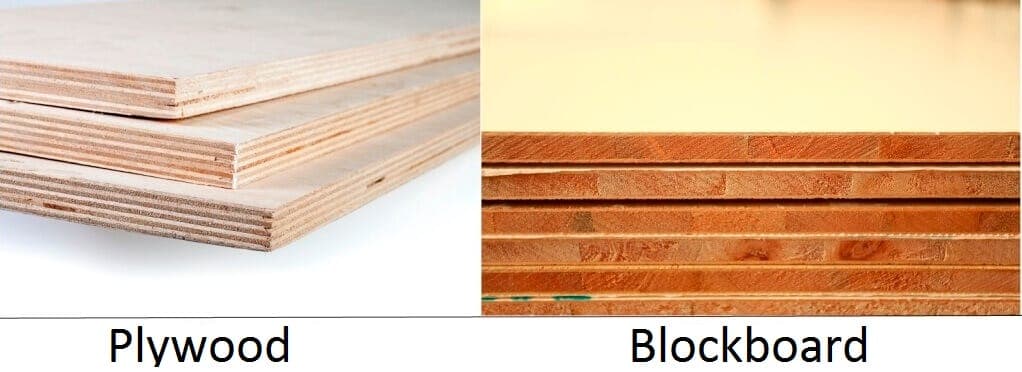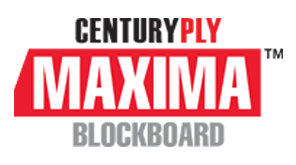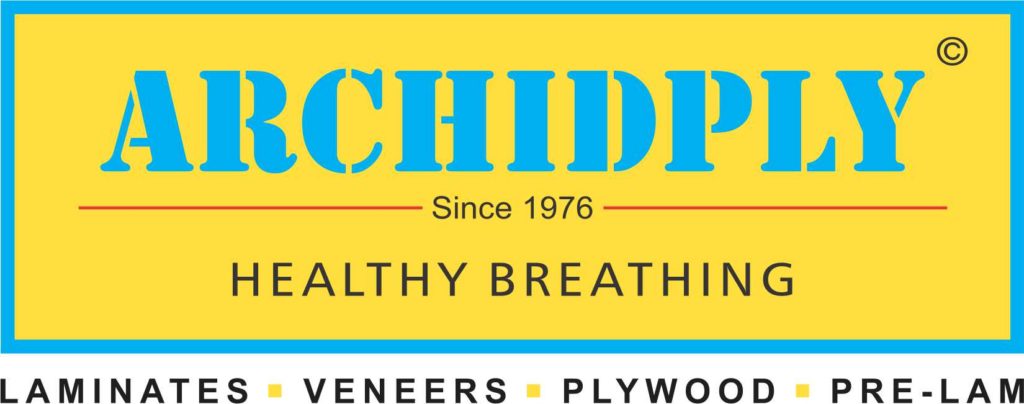
There are different types of engineered wood available in the market like plywood, blockboard, hardboard, MDF, particle board, etc. Plywood and blockboard both are popularly used for home décor and furniture making. Most manufacturers suggest that both the products are suitable for all purposes and hence homeowners are often confused as to which material should be used where. Both plywood and blockboard have their own set of distinctive properties which makes them very diverse from one another.Hence, here we give you a brief comparison of plywood vs blockboard to help you make the correct choice.
Plywood vs Blockboard
01. Material
- Plywood is a wooden panel made by stacking and gluing wood veneer sheets which are then pressed under high temperature to form sheets.
- It is wood based board which consists of a core made of softwood wood strips between the two layers of wood veneers. The strips are placed of edge to edge and are enclosed between hardwood veneer sheets and glued under high temperature and pressure.
02. Uses
- Most commonly used for making custom built furniture for homes and offices, except for the furniture with long spans as it is known to sag or bend from the center.
- It is also used in building construction in the form of concrete shuttering panels, floors, walls and roofs.
- BWR grade plywood (so called waterproof) is used in making kitchen cabinets and other kitchen furniture.
- It is used in making fences and signs for demanding outdoor advertising, etc.
- Marine grade plywood is used for making boats and ships.
- It is the most preferred choice when lengthy pieces of wood are required for furniture making as it is stiffer and does not bends or sags like plywood, like long book shelves, tables and benches, lengthy wall panels, wardrobes, doors, sliding, etc.
- Also it is light in weight, making it easy to transport and install, and hence it is the topmost choice for making exterior and interior doors.
03. Properties
(a) Resistance to Physical Components
(i) Water
- It is less susceptible to water damage.
- It is more prone to water damage than plywood as it is known to retain moisture.
(ii) Sagging and Bending
- Long pieces of plywood tend to bend and sag from the center.
- It is stiffer than plywood and hence is less prone to bending.
- So, if the length of furniture is more than 6-7 ft., blockboard is preferred over plywood.
(iii) Warping and Cracking
- It is resistant to warping and cracking.
Also Read: Blockboard: Properties You Need To Know!
- It has good dimensional stability and so is highly resistant to warping and cracking.
Also Read: Properties of Plywood as a Building Material
(iv) Splitting
- Plywood is known to split from edges when working with it.
- It does not split on cutting. So might give wavy look.
(b) Uniformity
- It is uniform throughout its length and breadth.
- It has minor gaps between the blocks which cannot be seen from outside.
(c) Weight
- It is heavier than blockboard as its core is made of hardwood veneer, which is quite dense and solid.
- It is light in weight than plywood because its core is made from softwood whose density and weight is less than that of hardwood.
(d) Cutting
- It is a little difficult to cut as compared to blockboard and will also splinter badly when cut.
- It is easy to work with and can be cut using regular wood work tools.
(e) Fitting
- It can hold screws and nails very well.
Also Read: Nails vs Screws: Which is Better for Furniture?
- It also has very good screw holding capacity like plywood but, often because of the gaps in between the blocks, the nails can sometimes go into the gaps instead of the wood and hence need skilled workers.
(f) Surface Finishing
- It can be easily painted, laminated, veneered or lacquered.
- It is available with various finishes such as plastic laminates, wood veneers, melamine paper, etc. It can also be painted and polished.
(g) Strength and Durability
- It has high strength as well as durability owning to its cross laminated structure.
- As it is made using softwood, it is not as strong as hardwood plywood.
- But, if hardwood strips are used, the strength of block board can be increased.
04. Size
- The most commonly manufactured and sold plywood size in India is 8 x 4 ft. (2449 x 1219 mm)
- It is available in various thicknesses ranging from 3 mm to 25 mm.
*Note: Customized sizes are available depending on different thickness
Also Read: What is the Size & Cost of Plywood?
- The most commonly manufactured and sold block board size in India is 8 x 4 ft. (2449 x 1219 mm).
- Available thickness:
- 16mm, 19mm, 25mm.
*This thickness includes the thickness of the softwood core blocks plus the front and back face veneers.
Also Read: Available Size & Cost of Blockboard
05. Maintenance
- Use a dry dusting cloth to remove dust and dirt.
- Do not let spills to stay on the surface and immediately clean it with a dry cloth.
- Use clean soft and dry cloth to remove dust.
- Do not wipe it with wet mop and make sure it stays away from water.
06. Life
- It holds up well for a very long time if not allowed to get wet. Plywood if laminated or veneered, can last for 50 years. In dry environment, its life can be increased by few more years.
- Blockboard has less life when compared with plywood. Compared to other engineered wood products, it is known to be stronger and last longer.
07. Cost
- It is costly as compared to blockboard.
- Blockboard is cheaper as compared to plywood as softwood strips are used in it.
Special Comments
Depending upon the application area and budget, plywood and block board should be selected. For custom made furniture which supports heavy loads and for kitchen cabinets, plywood is recommended. For furniture such as shelves, tables, benches, etc. blockboard is recommended.
From the above comparison of plywood vs blockboard, the user needs to make a judicious and rational choice depending upon your budget.
The popular manufacturers of plywood and blockboard in India are:
Also Read:
Advantages and Disadvantages of Plywood
Different Grades of Blockboard & Their Uses
MDF vs Plywood: Make The Right Choice
Advantages & Disadvantages of Blockboards





































